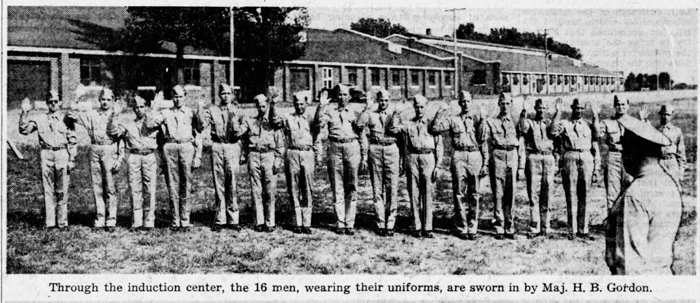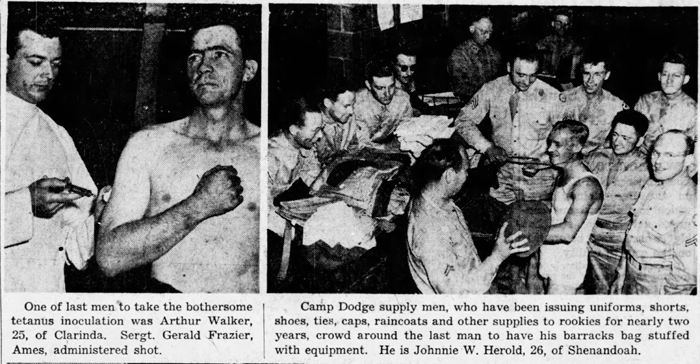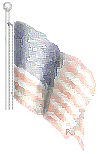Camp Dodge . . .

Camp Dodge Induction for Final Group
By George Mills.
Camp Dodge’s part in arming the nation for World War II has passed into history. The final contingent of 16 selectees, all from Page county, was put into uniform and classified before the weekend and will leave for training camps early this week.
From now on Iowa men called for military service will be sent to Fort Snelling, Minn., Jefferson Barracks, Mo., or Fort Leavenworth, Kan.
The camp, which also played a major role in World War I, became inactive from a selective service standpoint Saturday. Its basic training program came to an end two weeks ago.


The Rearguard.
The 16 young men from Shenandoah and Clarinda—truck drivers, salesmen, a farmer, some married, some single, one not even through high school yet—for the rearguard of a mighty Iowa army Camp Dodge has sent to war against Fascism.
More than 75,000 men went into the army and an undisclosed number entered navy service from Camp Dodge since it became an induction station and reception center in the summer of 1942.
Altogether the total is conceded to be well over 100,000. That’s the equivalent of a four-abreast column of men nearly 30 miles long with the lines six feet apart.
On Many Fronts.
Iowans who got their first taste of military life here have fought—and some have fallen—in Africa, Italy, Normandy, New Guinea, the Solomons, the Aleutians, Burma and elsewhere. They have dropped their lethal bomb loads on Axis installations in two hemispheres. They have scoured the seas aboard American warships in search of Japanese surface vessels and German U-boats.
Last man to receive his uniform at Camp Dodge for World War II was Johnnie W. Herold, 26, a Shenandoah wool and hides dealer who left a wife and four children behind him when he went away to war.
Last man to be given his “shots” was Arthur M. Walker, 25, of Clarinda, a shoe repair man with three children.
“I’d rather have been the last man through in 1950,” cracked one of his associates. “I come from a long line of civilians.”
One of the last rookies ventured an opinion that he would be in the army about 18 months.
“I don’t think the war will last that long but they’ll send the other boys home and shoot us over in their places, maybe for guard duty,” he said. He expects the war itself may be all over in a year.
When Herold came down along the counter to receive his uniform, Sergt. Leslie Faber of Kanawha, Ia., commented: “Here’s the man we’ve been waiting for.”
In 11 Seconds.
Faber, who rattles over clothing items so fast that not even a tobacco auctioneer could understand him, figures that he has checked the original supply issue of 50,000 rookies in his 22 months here. There are 57 issue items for each man and Farber’s speed record in reeling the off is 11 seconds.
He was in the feed mill business at Kanawha. His record volumn is 870 men in one day. He doesn’t know where the army will put him now.
Besides Herold and Walker, the final group included:
SHENANDOAH—Roy C. Hopkins, 25, bread salesman, married, two children;
James L. Waters, 24, oil salesman, married, one child;
Paul E. Jones, 23, hatchery business, married, one child;
Paul E. Stephens, 23, truck driver, married, three children;
James R. Burnside, 21, Omaha advertising agency employee, unmarried;
Robert J. LaFluer, 18, high school senior, unmarried.
CLARINDA—Harlan Lasley, 24, truck driver, married, two children;
Lawrence L. Beauchamp, 25, oil truck driver, married, one child;
Frank J. Gay, 23, truck driver, married, two children;
Freddie Holder, 20, farmer, unmarried;
Richard C. Zahm, 19, unmarried, worked for shipping association;
Donald L. Stewart, 18, truck driver, unmarried;
Paul L. Harris, jr., 18, University of Iowa student, unmarried.
The sixteenth was Oscar G. Rood, 25, of St. Louis, Mo., an electric blueprint supervisor, married, three children. He was part of the Page county quota because he registered there while serving in a civilian conservation corps (CCC) camp.

Source: The Des Moines Register, July 2, 1944
![]()
